Leaders are paid to think clearly. And a big impediment to clear thinking is what CBT/REBT calls Cognitive Distortions: errors in thinking or thinking traps we commonly fall for. Most high-performers are not pathological, but instead fall for them when upset or in high-stress situations.
In this post, I share 17 of the most common cognitive distortions. I highlight the use-cases of leaders and job-hunters, what causes them, and strategies for countering them.
What are cognitive distortions?
Also known as thinking errors or thought traps, cognitive distortions are defined as "errors of processing in which the person cognitively focuses on insufficient or inappropriate data and draws illogical conclusions, makes inaccurate inferences or bases predicted outcomes upon little or no empirical evidence." [3]
Put simply, these are habitual but unhelpful ways of thinking. Why are they important?
Because the way we feel, and how well we operate, are directly dependent on the quality of our thinking. It's not external events or others that make us feel a certain way, but instead our thoughts about them. But this process is so fast and automatic that we forget our own role in creating these problems.
Your emotions result entirely from the way you look at things. It is an obvious neurological fact that before you can experience any event, you must process it with your mind and give it meaning. You must understand what is happening to you before you can feel it.
...
It is not the actual events but your perceptions that result in changes in mood. When you are sad, your thoughts will represent a realistic interpretation of negative events. When you are depressed or anxious, your thoughts will always be illogical, distorted, unrealistic, or just plain wrong.
— David Burns [1]
Are cognitive distortions applicable to leadership coaching
In leadership, staying alert to cognitive distortions is important from two key perspectives: the leader's performance, and more importantly, how it affects others.
Elite athletes have to train constantly to maintain peak physical and mental conditioning. Their training routines focus on maintaining correct form. The equivalent of good form in leadership is clear thinking. Most high-functioning folks are not necessarily pathological, but nevertheless fall for these subtle but hidden patterns.
Additionally, leadership behavior has ripple-effects throughout the organization. People not only copy leaders, but also seek answers from them, both direct and implied. Whether by design or accident, leaders are always setting the context for their teams. It's why they simply cannot afford to get derailed by thought traps.
Common cognitive distortions
Just as exercise improves physical strength, there are practices to improve mental conditioning — aka clear thinking. One such practice is to learn, identify, and interrupt common but unhelpful thinking patterns that we fall for.
Leadership coaching borrows from a range of disciplines including cognitive behavioral methods. What follows are the most common cognitive distortions that CBT/REBT recognizes.
Each cognitive distortion is followed by examples from the perspective of a job-hunter and a leader. Why? Thinking errors are most likely when operating in high-stress situations which are rich territory for thought traps.
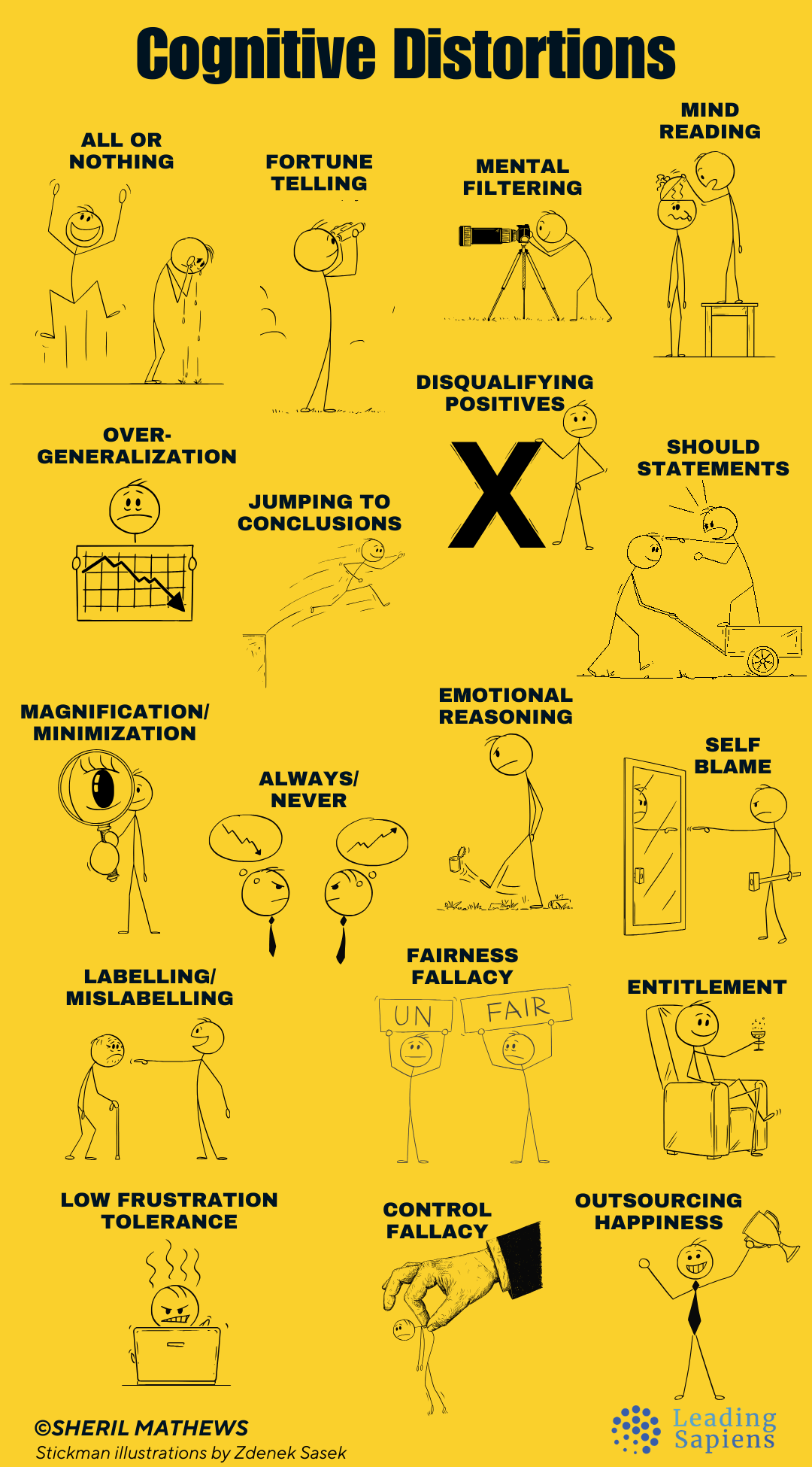
(1) All-or-Nothing Thinking
Definition
We see the world in dichotomies — it's either black or white with no shades of grey in between. Anything short of perfect is a failure. Characterized by thinking in polarities, extremes, and absolutes. It's either excellent or awful, and forms the basis of perfectionism.
Examples
⦿ Leader: "If my team doesn't achieve 100% of the goals, it's a complete disaster."
⦿ Job-Hunter: "If I don't get this job, I'll never find a good career opportunity."
How to counter
Cultivate multi-category thinking and a richer understanding to see the shades of grey instead of falling for simplistic explanations. Learn to discern between facts vs hunches or interpretations. Resolve to examine your negative interpretations by testing them out.
(2) Overgeneralization
Definition
Drawing broad conclusions based on isolated negative events. Characterized by drawing global beliefs and never-ending patterns from a single situation.
Examples
⦿ Leader: "My proposal got rejected ; I'm terrible at pitching ideas."
⦿ Job-Hunter: "I failed this interview; I'll never get hired anywhere."
How to counter
Avoid extrapolation of both good and bad. And when doing so, check if the data actually supports your stance.
(3) Mental filtering
Definition
Picking out and focusing exclusively on a single negative aspect while ignoring any positives.
Examples
⦿ Leader: "Despite other successful projects, I can't stop thinking about that one recent failure."
⦿ Job-Hunter: "I had an excellent interview, but I stumbled on one question, and now I feel like I ruined it all."
How to counter
Recognize the complexity of situations and acknowledge positive aspects as well that balance out the negative.
(4) Disqualifying the positive
Definition
Rejecting positive experiences as if they don't count for one reason or another. A simple example is dismissing compliments. Success is seen as a fluke. This make it difficult to build on anything because everything is happenstance.
Examples
⦿ Leader: "The team's success was due to external factors, not my leadership."
⦿ Job-Hunter: "The interviewer praised my skills, but I think they were just being polite."
How to counter
Learn to accept and acknowledge positive feedback and explanations, in addition to negative and neutral ones.
(5) Jumping to Conclusions
Definition
Assuming negative outcomes, or negative interpretation without facts or supporting evidence. This is characterized by certainty in interpreting situations despite little evidence.
Examples
⦿ Leader: "He's late today; he must not care about work."
⦿ Job-Hunter: "The interviewer looked uninterested; they probably think I'm unqualified."
How to counter
Notice your inferences and how far removed they might be from observable facts. Learn to test your inferences and hunches.
(6) Magnification (Catastrophizing) Or Minimization
Definition
Exaggerating or downplaying the importance of events. Also known as the "binocular trick".
Examples
⦿ Leader: "Missing this deadline will ruin my career."
⦿ Job-Hunter:"If I don't get this job, I'll never find any job, and my life will be ruined."
How to counter
Use a balanced perspective instead of a skewed one that catastrophes or minimizes. How would an outside observer view your situation? What are your strengths?
(7) Emotional Reasoning
Definition
Believing feelings and negative emotions accurately define or reflect reality. The logic goes: "I feel it, so it must be true."
Examples
⦿ Leader: "I feel like a failure, so I must be incompetent."
⦿ Job-Hunter: "I'm nervous about the interview, which means I'll perform poorly."
How to counter
Get separation between facts and how you feel about something. Discern between emotionally laden assessments vs. factual takes.
(8) Should Statements
Definition
Trying to motivate yourself by holding rigid or unrealistic expectations on oneself or others. Characterized by should(s), shouldn't(s), musts, oughts and "have to's", as if one has to be punished and whipped before correct behavior. Albert Ellis (REBT founder) called this MUSTerbation.
Examples
⦿ Leader: "I should always have the solution to every problem."
⦿ Job-Hunter: "Employers should always provide feedback after interviews."
How to counter
Stay alert to your use of language and how that influences your interpretations, choice of actions, and behavior.
(9) Labeling and Mislabeling
Definition
This is an extreme form of overgeneralization, where we assign global, negative labels to oneself or others. Instead of describing an error, we attach negative labels: "I'm a loser", or: "what a louse". It's often characterized by highly colored and emotionally laden language. Over time, this can also lead to a lack of separation between the label and identity. Eg. "I'm a nervous nelly".
Examples
⦿ Leader: "I'm a total failure as a manager."
⦿ Job-Hunter: "I'm a slouch when it comes to interviews."
How to counter
Avoid using labels or rating yourself/others globally. Almost no-one is a "total idiot" or a "complete failure". Question the validity of your labels and separate the behavior from the person.
(10) Personalization
Definition
Also known as self-blame: you assume undue responsibility for negative external events for which you were not responsible. This is an easy trap for conscientious leaders – they've confused influence with control.
Examples
⦿ Leader: "The project's failure is entirely my fault."
⦿ Job-Hunter: "I didn't get the job; I must have said something wrong during the interview."
How to counter
Try to understand the whole picture instead of one particular aspect that you might have contributed to. Look for alternative explanations that might highlight different causal factors.
(11) Mind-reading
Definition
Believing you know what others are thinking about you without evidence. It also means assuming that others know what you are thinking. It's characterized by a lack of direct communication (they should know), and expecting others to read your body language.
Examples
⦿ Leader: "My team thinks I'm incompetent."
⦿ Job-Hunter: "The interviewer didn't like my answer."
How to counter
Check your interpretations of others' reactions instead of assuming it's obvious. Look for alternative explanations that are more generous.
(12) Fortune-teller error
Definition
Predicting future events, usually negative, without evidence. And acting as if your prediction is a fact. Often characterized by anticipation of bad events and assuming outcomes as foregone conclusions. There's a false sense of hopelessness and defeatism.
Examples
⦿ Leader: "I know the client will reject our proposal."
⦿ Job-Hunter: "I'm certain they won't hire me, so why apply."
How to counter
Discern between what's in your control and what's not. Avoid making predictions that are not actually in your control. Let the decision-makers do their job while you do yours.
(13) Always/Never Thinking
Definition
Believing that negative events will always happen, or that good events will never happen.
Examples
⦿ Leader: "My team always makes mistakes."
⦿ Job-Hunter: "I'll never get hired."
How to counter
Take a balanced view of the past, present, and future. Recognize that while bad events are always possible, they're not inevitable and can be mitigated. Meanwhile, positive events are equally likely.
(14) Entitlement
Definition
Believing one deserves special treatment or privileges, and characterized by unrealistic expectations and demanding behavior based on status.
Examples
⦿ Leader: "I should be promoted without having to prove myself."
⦿ Job-Hunter: "The employer should hire me because of my qualifications."
How to counter
Watch out for status expectations and wanting to skirt effort in getting to your goals.
(15) Outsourcing Happiness
Definition
Emotional dependence and reliance on external circumstances for happiness instead of internal control. Characterized by the logic: "I'll be happy when/if..."
Examples
⦿ Leader: "I'll be happy when my team performs well."
⦿ Job-Hunter: "Getting this job will make me happy."
How to counter
Watch out for when you make your happiness contingent on something outside your control.
(16) Control Fallacy
Definition
Believing external forces have complete control over one's life (helplessness). Or the opposite of everything being in our control.
Examples
⦿ Leader: "I'm powerless against the company's decisions."
⦿ Job-Hunter: "The job market controls my job prospects."
How to counter
Most of the time, we have more choice than we realize. But often this choice is hidden behind consequences that we might not be ok with.
(17) Fairness Fallacy
Definition
Believing that life should always be fair and just. Characterized by resentment and frustration.
Examples
⦿ Leader: "It's not fair that my colleague got promoted, and I didn't."
⦿ Job-Hunter: "I deserved that job more than the other candidates."
How to counter
Culture programs us to expect fairness, but the world is far from being fair, let alone predictable. Don't allow expectations of fairness to scuttle your level of commitment and effort.
What causes Cognitive Distortions?
While recognizing and countering cognitive distortions is useful, it's also valuable to go further upstream and understand what causes them to begin with. REBT has two constructs that explain what causes distortions: levels of cognitions and irrational beliefs.
(a) Levels of cognitions
REBT postulates that our disturbed mental states and unhelpful emotions follow from thinking that happens at three levels [6].
- First level: perceptions, automatic thoughts, and negative attributions (inferential)
- This is the level at which cognitive distortions occur. It's what we're aware of and that forms our stream of consciousness. These thoughts are inferential in nature. Eg. "He didn't like my work"/"I fail at everything"/"I am stupid". Because they're inferences, they can be tested.
- Second level: awfulizing, global evaluations, and frustration intolerance (evaluative), that are derived from the third level.
- They evaluate the importance of the inferences: the badness of the inference(awfulizing), evaluation of your ability to tolerate the situation (frustration intolerance), or worth of person involved (global evaluations).
- Third level: the core irrational belief of "demandingness" from which everything else follows. (imperative/schematic)
- Also known as "imperative demands" , these are thoughts about the way reality "should" be. They are core beliefs that follow the construct of " I must", "you must", or "the world must". Albert Ellis calls this MUSTerbation — expectations about the way the world is, ought to be, and what is good or bad about what is/ought to be. Words like "should", "ought", "must" and "have to" represent demandingness.
(b) Types of irrational beliefs
REBT recognizes 5 basic types of irrational beliefs that underlie cognitive distortions: demandingness, awfulizing, frustration intolerance, self-worth ratings, and other-worth ratings.
Demandingness is an unrealistic and absolute expectation of events or individuals being the way a person desires them to be.
Awfulizing is an exaggeration of the negative consequences of a situation to an extreme degree, so that an unfortunate occurrence becomes “terrible".
Frustration Intolerance (FI) stems from demands for ease and comfort, and reflects an intolerance of discomfort.
Global evaluations of human worth, either of the self or others, imply that human beings can be rated, and that some people are worthless, or at least less valuable than others.
[6]
The most common situations where we use these irrational belief processes happen in these contexts: social relationships, achievement, comfort, and fairness.
How to use this list of Cognitive Distortions
The key is to understand that thought patterns are akin to muscle movements.
Habitual ways of thinking have an evolutionary purpose — they help our brains use less energy, draw conclusions faster, and move on with our lives. We get used to a certain way of doing (in this case thinking), and the only way to change/improve is to do it differently, and getting the new “movement” into muscle memory. In this case, your neural pathways.
But to do that, you have to first recognize them. We cannot improve something we don’t notice. Identifying the usual suspects beforehand helps raise our level of awareness, which in turn helps in disrupting habitual patterns.
⦿ Familiarize yourself with the common ones.
⦿ Identify 2-3 patterns you regularly fall for.
⦿ Target those in the coming weeks.
⦿ Practice identifying them.
⦿ Replace those recurring patterns with counter narratives.
⦿ Practice just as you would practice scales in music, or weights for building muscle.
Reading about them raises awareness, but changes are not sustained without practice.
In addition to the specific countering of cognitive distortions, below are some general approaches you can use to improve your thinking and avoid these thought traps.
Thought record journals
Writing down your thoughts and identifying what distortion you might be falling for is super helpful. Done consistently, this practice in itself can literally rewire your neural system.
Self-Compassion
If you were advising your friend in a similar situation, what might you tell them? We're often much harsher on ourselves than with others.
Relative thinking
Learn to recognize the complexity of problems and situations and how your take might be too simplistic. Extreme interpretations require extreme simplification.
Scientific thinking
Always be searching for evidence. Test out your interpretations and get feedback from multiple sources. A useful tool for seeking critical feedback and identifying potential blindspots is the Johari Window.
Watch out for emotive language
Be extra alert to “musts”, “should”, “oughts”, “have to’s”, “it’s awful”, “I can’t stand it”, “never”, and so on.
Identify your level of thinking
Follow the chain of inferences down the levels of thinking and identify what irrational belief might be driving your distortion. Another useful tool is the ladder of inference.
Cost-benefit analysis
Is your particular approach or way of thinking helpful or harmful? Are there alternate explanations that might be more beneficial?
Further reading
Below are some related articles that build and add to the concepts discussed above.
- Instead of learning new mental models, it's often more productive to identify and dismantle hidden but unhelpful mental models:
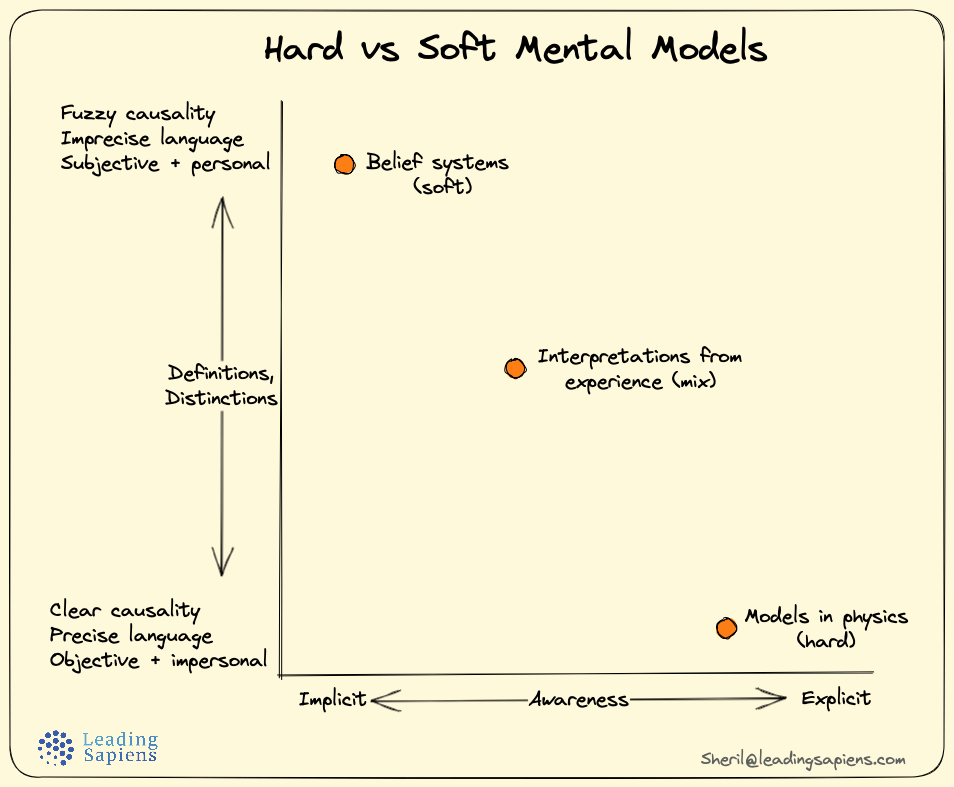
- Double-loop learning: a simple model of performance and what lies upstream
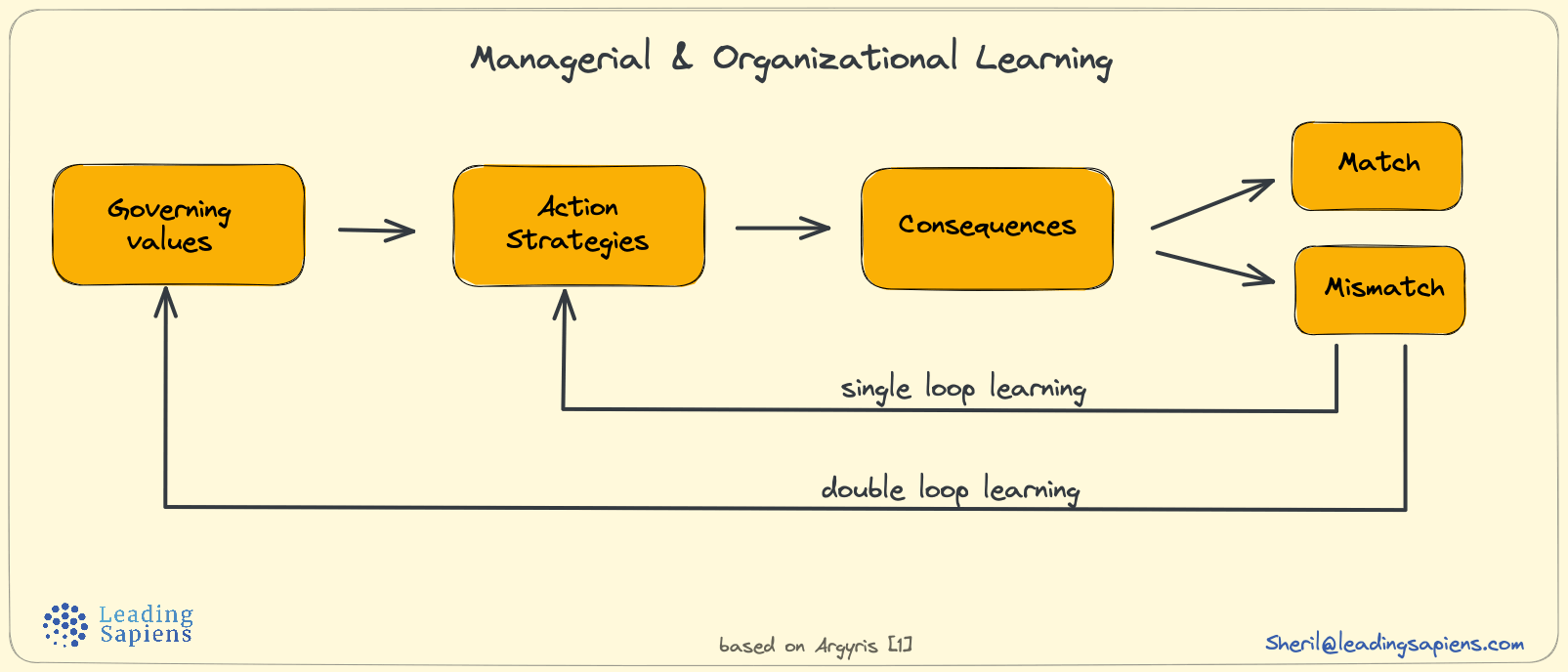
- The ladder of inference is a useful framework that shows how we go from facts to inferences to actions:
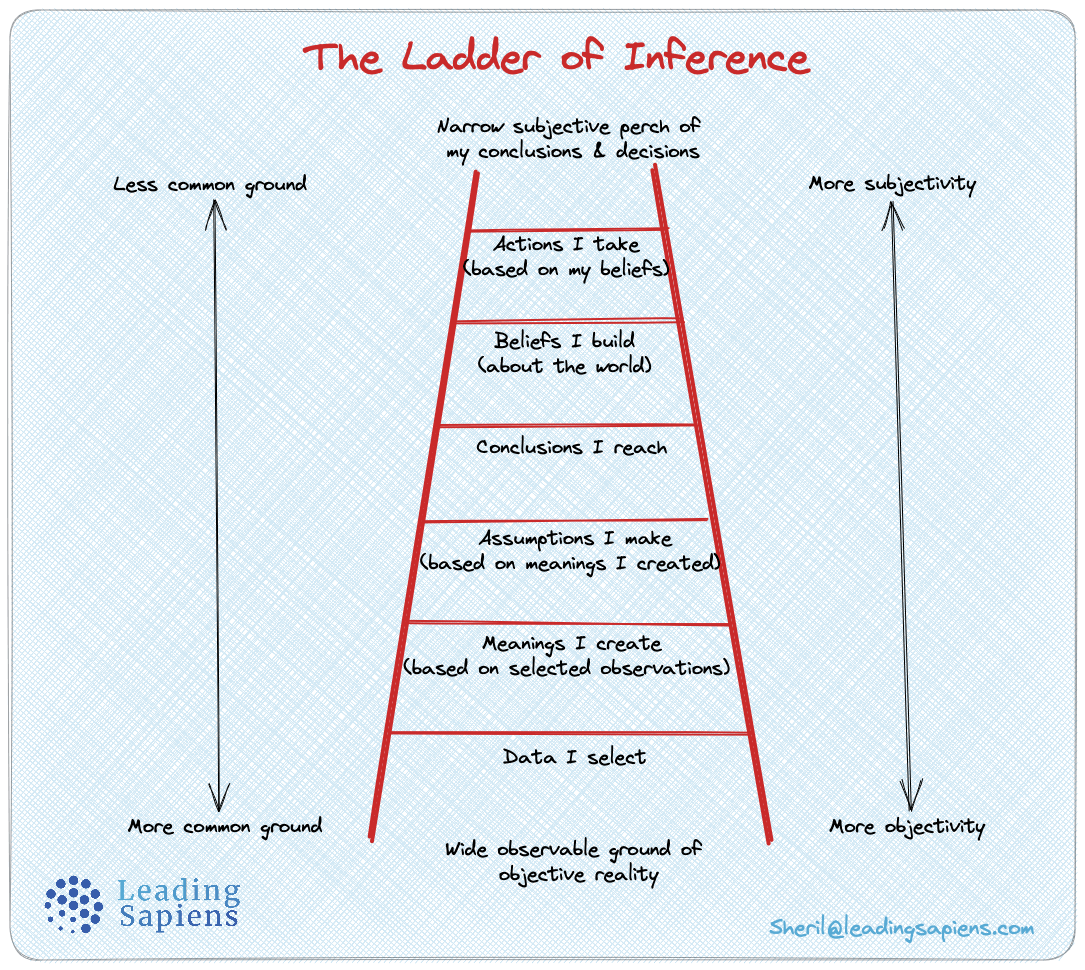
- Imposter syndrome is one kind of cognitive distortion/thought trap:
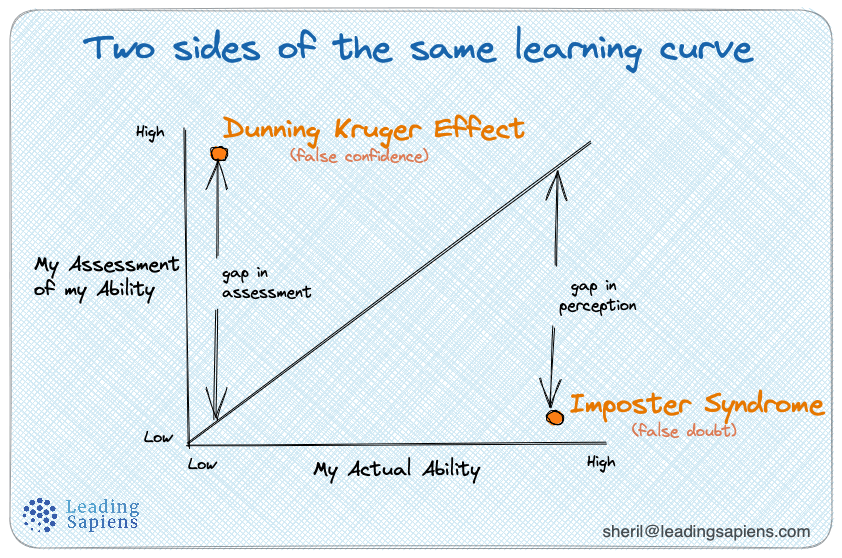
Sources
- Feeling Good by David Burns
- The Anxious Achiever by Morra Aarons-Mele
- Handbook of Coaching Psychology by Stephen Palmer, Alison Whybrow
- Dealing with Emotional Problems Using RECBT by Windy Dryden
- Evidence Based Coaching Handbook by Dianne Stober, Anthony Grant
- A Practitioner's Guide to REBT by Raymond DiGiuseppe, Kristen Doyle, Windy Dryden, Wouter Backx



